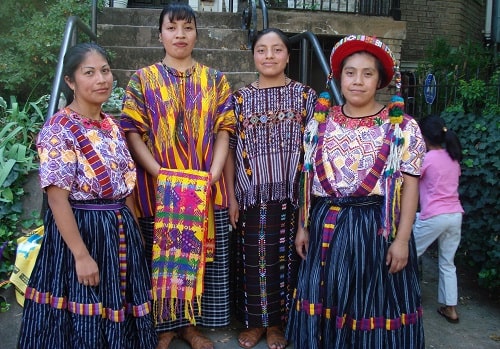Trama Textiles is one of the several Guatemalan workshops that has gained international renown for its exquisitely woven textiles. Indigenous people in Guatemala are carrying on a longstanding tradition of making and wearing elaborately decorated, brightly colored garments, despite the pressures of globalization.
Given the worldwide exposure of racial discrimination in recent years, it is all the more important to recognize and celebrate those who proudly display their cultural identity.
Although small in size, Guatemala is home to a wealth of traditions and practices rooted in Mayan culture that have been carried down to the generations. Varying regions of Guatemala have vastly varying styles of traditional dress, and the country is home to at least 24 separate languages.
The local history, mythology, religion, fauna, natural features, and climate all have an impact on the traje worn by the indigenous people of a certain area. The emblematic bird of Guatemala, the quetzal, is typically shown in the colorful designs which are weaved into the cloth.
To convey the myths and traditions of the local people and their culture, godlike creatures are sometimes depicted. Diamonds, triangles, zigzags, and curved lines are frequently used to represent volcanoes, mountains, and rivers in geometric patterns and designs. Indigenous clothing is so intrinsically linked to the identity of its wearers.
Traditional dress for men
A male from the same region would wear a Western-style sweater and pants with a chaqueta, or open jacket, a straw hat created in the region, and boots. Because it is less expensive and more functional than traditional hand-made garments, men are more likely to adopt basic Western-style clothing than women. Men looking for marriages, however, place a premium on women who can weave.
The Maya youngsters wear traditional traje to class because they understand the value of keeping their culture alive.
Traditional dress for women
Huipil
A huipil is a traditional indigenous top. Women spend anything from a few weeks to many months weaving each blouse by hand on a back-strap loom. Each one is one of a kind. The ‘nahual’ is an integral part of the brocaded pattern on several huipiles. The shape of the figure in the pattern of this blouse is significant because in K’iche Mayan belief, everyone is guarded and watched over by a nahual.
Faja
The cortes that Mayan women wear are held in place by belts or sashes. Belts are created from long pieces of material, which are usually adorned with elaborate patterns.
Corte
Cortes, the traditional skirt, are made by wrapping a long length of fabric around the wearer’s waist and securing it with a belt or sash. You can see the huipil inside the corte.
Tzute
For women in Guatemala, this is a crucial part of their traditional dress. It’s a versatile piece of cloth worn for a variety of reasons, such as to cover one’s shoulders and head as one enters a church, to carry a baby on one’s back, to cover one’s food baskets while on one’s back, or as a stylish headgear.
Maya women weaved clothes on the backstrap loom for millennia. The weaver’s waist strap is known as the backstrap. Weavers frequently construct their own portable looms. They only need to be fastened to trees or a solid post. Maya girls are trained by elders to do weaving on this loom as early as they can hold a needle.
Weavers generate the vibrant hues by organically dying cotton yarn with vegetables, flowers, herbs, and bark.
While women still make up the majority of those seen in traje, men can occasionally be spotted in select communities donning their own traje of decorated shirts and slacks.
Famous for their vivid hues, Maya textiles can show a wide range of designs, from geometric patterns like diamonds and stars to more organic ones like flowers and insects and even human figures like saints. There are a lot of symbols, and they all symbolize something different in Mayan civilization.
The Maya believe that the serpent’s feathered god Gucumatz, who is depicted in their art as a zigzag pattern, was responsible for creating humanity. It is also said that the serpent will watch over us as we travel through life.
Conclusion
The traje, traditional dress of Guatemala is more than simply for show. Prominent Indigenous women have long advocated for the wearing of traje tipico; for example, Rigoberta Menchu wore her traje when she accepted the Nobel Peace Prize in 1992. Many Native Americans count on it as a symbol of their identity and a point of pride.


